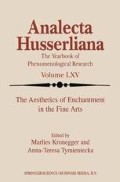Abstract
Any semantics — especially a semantics of aesthetic judgment — must consider the relation between affective tones and conceptual thought in the determination of the meaning of meaning even if that relation is merely determined to be a negative one. The central question facing any account of the semantics of affects, and thus likewise an account of aesthetic enchantment, is whether it is affects or beings that found the meaning of the relationship between human beings and their world. In section 51 of Kant’s Critique of the Faculty of Judgment, we find Kant entangled in one of only two instances of hesitation in his entire critical project.1 In this paper, I will show that the reason that Kant provides for his hesitation is merely a “surface” cause, and that the “deep” cause of his hesitation stems from a confrontation with the problem of finding the adequate model for meaningful expression. I will then show that this issue that remains a mere hesitation in Kant’s work has attained the status of a genuine philosophical problem in contemporary phenomenology.2
Access this chapter
Tax calculation will be finalised at checkout
Purchases are for personal use only
Preview
Unable to display preview. Download preview PDF.
Notes
Concerning this indecision, see also Derrida’s The Truth in Painting, trans. Geoff Bennington and Ian McLeod. U. Chicago Press: Chicago, 1987; p. 116. References to Kant are from his Critique of Judgment, trans. Werner S. Pluhar. Indianapolis: Hackett, 1987. [Henceforth, CJ with English paginations followed by the German paginations of Kants gesammelte Schriflten in parentheses.]
References there will be to Edmund Husserl’s Logical Investigations, 2 vols., trans. J. N. Findlay. London: Allen & Urwin, 1977. [Henceforth, LI I1.] Martin Heidegger, Being and Time, Trans. Joan Stambaugh. Albany: SUNY Press, 1996. [Henceforth, BT.1
CJ, p. 189 [320].
CJ, ft. 58, p. 190 [320].
See a more broad discussion of the analogy offered by Hartley Slater’s “The System of the Arts,” The Journal of Aesthetics and Art Criticism, 51:4, 1993; pp. 611–617.
See also Martin Weatherston’s article, “Kant’s Assessment of Music in the Critique of Judgment, ” 36:1, Jan. 1996; pp. 56–65.
CJ, p. 200 [330].
CJ, p. 198 [328].
CJ, p. 199 [328].
This discussion is indebted to Herman Parret “Le timbre de l’affect et les tonalités affectives,” Revue Internationale de la philosophie, 48:189, 1994; pp. 287–302.
For a more detailed account of the relation between feeling and fine art, see Paul Guyer’s “Kant’s Conception of Fine Art,” The Journal of Aesthetics and Art Criticism, 52:3, Su. 1994; pp. 275–285.
CJ, p. 44 [204].
For a fascinating critique of Husserl’s analysis of affect, see one of Levinas’ numerous studies of affectivity: “Affectivity as the Ipseity of the I,” in Totality and Infinity: An Essay on Exteriority, trans. Alphonso Lingis. Pittsburgh: Duquesne University Press, 1969.
Edmund Husserl, Ideas Pertaining to a Pure Phenomenology and to a Phenomenological Philosophy, Book!,trans. Fred Kersten. The Hague and Boston: Kluwer, 1982.
This relation receives special emphasis in Heidegger’s “What is Metaphysics?” in Basic Writings, trans. David Farrell Krell. San Francisco: Harper & Row, 1977.
These analyses can be found under Heidegger’s heading “Being-in as Such,” especially § 30 & § 36.
For an account of the role of the phenomenological reduction in Being and Time, see J.-F. Courtine, Heidegger et la phénoménologie. Paris: J. Vrin, 1990.
See Jean-Luc Marion, Réduction et Donation. Recherches sur Husserl, Heidegger et la phénoménologie. Paris: PUF, 1989.
Although our time is prohibitive, we could also continue in this line by following the accounts of affectivity provided by Merleau-Ponty’s notion of incarnation, and by Levinas’ notion of interiority. For both these thinkers, affectivity is also central to the determination of the expressivity of phenomena, and there can be no determination of being independent from an affective dimension.
Author information
Authors and Affiliations
Editor information
Editors and Affiliations
Rights and permissions
Copyright information
© 2000 Springer Science+Business Media Dordrecht
About this chapter
Cite this chapter
Davidson, S.C. (2000). The Ambiguous Meaning of Musical Enchantment in Kant’s Third Critique. In: Kronegger, M., Tymieniecka, AT. (eds) The Aesthetics of Enchantment in the Fine Arts. Analecta Husserliana, vol 65. Springer, Dordrecht. https://doi.org/10.1007/978-94-017-3234-5_7
Download citation
DOI: https://doi.org/10.1007/978-94-017-3234-5_7
Publisher Name: Springer, Dordrecht
Print ISBN: 978-90-481-5405-0
Online ISBN: 978-94-017-3234-5
eBook Packages: Springer Book Archive

